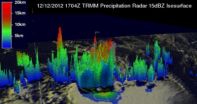(Press-News.org) NASA's Tropical Rainfall Measuring Mission or TRMM satellite continues to provide rainfall and cloud height data on powerful Cyclone Evan as it crawls through the Samoan Islands with hurricane-force winds and heavy rains. NASA's TRMM satellite identified "hot towers" in the storm, hinting that it would continue to intensify.
On Dec. 14, American Samoa, Tonga and Fiji are all under warnings or alerts as Evan continues to move west. A gale warning is in effect for Tutuila and Aunuu. A high surf warning is in effect for all of American Samoa. A flash flood watch is in effect for Tutuila and Manua. A tropical cyclone alert is in force for Niuafo'ou and Fiji.
The TRMM satellite had an excellent view of tropical cyclone Evan on Dec. 12, 2012 at 1704 UTC when it was battering the Samoan Islands with hurricane force winds. Evan is predicted by the Joint Typhoon Warning Center (JTWC) to intensify and have winds of 130 knots (~150 mph) while remaining close to the islands. This wind speed would make it a strong Category 3 storm on the Saffir-Simpson Scale. A storm surge of 4.5 meters (14 feet) was already reported along the Samoan coast.
Evan's rainfall was analyzed using TRMM's Microwave Imager (TMI) and Precipitation Radar (PR) data. This analysis showed that the heaviest rainfall of over 80 mm (~3.1 inches) per hour was occurring in heavy rainfall within Evan's clear eye wall. Strong bands of thunderstorms were seen wrapping into the low level center of circulation.
TRMM's Precipitation Radar (PR) data sliced through Evan and were used to provide the 3-D cut-a-way view looking at Evan's northern side. The imagery clearly showed the vertical side surface of Evan's well-defined eye.
TRMM data revealed several "hot towers" or towering thunderstorms reaching heights of greater than 16.5 km (10.25 miles) within Evan's eye wall. A "hot tower" is a tall cumulonimbus cloud that reaches at least to the top of the troposphere, the lowest layer of the atmosphere which extends approximately nine miles (14.5 km) high in the tropics.
VIDEO:
TRMM data on Dec. 12, 2012 at 1704 UTC revealed several "hot towers " or towering thunderstorms in Cyclone Evan reaching heights of greater than 16.5 km (10.25 miles) within Evan's...
Click here for more information.
These towers are called "hot" because they rise to such altitude due to the large amount of latent heat. Water vapor releases this latent heat as it condenses into liquid. NASA research shows that a tropical cyclone with a hot tower in its eyewall was twice as likely to intensify within six or more hours, than a cyclone that lacked a hot tower.
On Dec. 14 at 1500 UTC (10 a.m. EST) Cyclone Evan had maximum sustained winds near 100 knots (115 mph/185 kph). Cyclone-force winds extend 35 nautical miles (40 miles/64.8 km) out from the center, while tropical-storm-force winds extend up to 105 miles (120.8 miles/194.5 km) from the center.
Evan was centered about 135 nautical miles (155.4 miles/250 km) northwest of Pago Pago, American Samoa, near 12.9 south latitude and 172.5 west longitude. Evan was moving slowly west at 5 knots. Evan is creating very rough seas with waves up to 32 feet (9.7 meters) high. Evan is a threat to American Samoa, Tonga and Fiji.
Evan is moving west away from American Samoa and will later turn southwest, away from American Samoa and is expected to continue to intensify as it moves just north-northwest of Fiji through Dec. 19.
INFORMATION:
For more information about the regional warnings, visit:
American Samoa: A gale warning is in force for Tutuila and Aunuu.
http://www.nws.noaa.gov/view/validProds.php?prod=HLS&node=NSTU
Tonga: A tropical cyclone alert is in force for Niuafo'ou.
http://www.met.gov.fj/aifs_prods/20027.txt
Fiji: A tropical cyclone alert is in force for Fiji.
http://www.met.gov.fj/aifs_prods/20020.txt
NASA sees Tropical Cyclone Evan batter and drench Samoan Islands
2012-12-15
ELSE PRESS RELEASES FROM THIS DATE:
In decision-making, it might be worth trusting your gut
2012-12-15
Turns out the trope is true: You should trust your gut -- as long as you're an expert. So says a new study from researchers at Rice University, George Mason University and Boston College.
"How expert someone is within a particular domain has a positive impact on their ability to make an accurate gut decision," said Rice's Erik Dane, lead author of a study published last month in the journal Organizational Behavior and Human Decision Processes. However, he added, "Even if you're an expert, intuitive decision-making is better for some types of tasks than others. Tasks that ...
Dreidel-like dislocations lead to remarkable properties
2012-12-15
HOUSTON – (Dec. 14, 2012) – A new material structure predicted at Rice University offers the tantalizing possibility of a signal path smaller than the nanowires for advanced electronics now under development at Rice and elsewhere.
Theoretical physicist Boris Yakobson and postdoctoral fellow Xiaolong Zou were investigating the atomic-scale properties of two-dimensional materials when they found to their surprise that a particular formation, a grain boundary in metal disulfides, creates a metallic – and therefore conducting – path only a fraction of a nanometer wide.
That's ...
We're all living longer, but longevity increases not benefitting everybody
2012-12-15
TORONTO, ON – Global lifespans have risen dramatically in the past 40 years, but the increased life expectancy is not benefitting everybody equally, say University of Toronto researchers. In particular, adult males from low- and middle-income countries are losing ground.
People are living longer on average than they were in 1970, and those extra years of life are being achieved at lower cost, the researchers, led by U of T Chemical Engineering PhD candidate Ryan Hum, say in a paper published in the open access science journal eLife this month.
However, the costs for ...
The HER2 paradox: HER2-positive stem cells found in HER2-negative breast cancer
2012-12-15
(SACRAMENTO, Calif.) — A multicenter study led by researchers at UC Davis describes new, paradoxical characteristics of the most common type of breast cancer. The findings shed light on how the disease can evade treatment and could improve diagnosis and treatment of breast cancer.
The research, led by Jian Jian Li, director of translational research in the UC Davis Department of Radiation Oncology, examined breast tumors previously thought to lack the HER2 protein, which, when over-expressed, is associated with disease recurrence. Instead, researchers found in the tumors ...
UCLA engineers develop new energy-efficient computer memory using magnetic materials
2012-12-15
By using electric voltage instead of a flowing electric current, researchers from UCLA's Henry Samueli School of Engineering and Applied Science have made major improvements to an ultra-fast, high-capacity class of computer memory known as magnetoresistive random access memory, or MRAM.
The UCLA team's improved memory, which they call MeRAM for magnetoelectric random access memory, has great potential to be used in future memory chips for almost all electronic applications, including smart-phones, tablets, computers and microprocessors, as well as for data storage, ...
A drug used to treat HIV might defuse deadly staph infections
2012-12-15
A new study by NYU School of Medicine researchers suggests that an existing HIV drug called maraviroc could be a potential therapy for Staphylococcus aureus, a notorious and deadly pathogen linked to hundreds of thousands of hospitalizations each year. Their study is published online this week in Nature.
"What are the chances that a drug for HIV could possibly treat a virulent Staph infection?" asks Victor J. Torres, PhD, assistant professor of microbiology, and senior author of the study. "These findings are the result of a fantastic collaboration that we hope will result ...
Ibrutinib has 'unprecedented' impact on mantle cell lymphoma
2012-12-15
ATLANTA - An international study of ibrutinib in people with relapsed or refractory mantle cell lymphoma (MCL) continues to show unprecedented and durable results with few side effects.
Researchers from The University of Texas MD Anderson Cancer Center presented interim findings of the multi-center Phase 2 study today at the 54th American Society of Hematology Annual Meeting and Exposition.
"I believe we are witnessing a breakthrough in mantle cell lymphoma. This is great news for patients," said Michael Wang, M.D., associate professor in MD Anderson's Departments of ...
If you cut down a tree in the forest, can wildlife hear it?
2012-12-15
BOZEMAN, MT (December 13, 2012) – A new tool developed by the Wildlife Conservation Society (WCS) and its partners is being used by scientists and land managers to model how noise travels through landscapes and affects species and ecosystems— a major factor in land and wildlife management decisions such as where to locate new roads or recreational trails.
The tool, SPreAD-GIS, uses spatial data layers to predict how sound spreads from a source through the surrounding landscape and how it is affected by such factors as vegetation, terrain, weather conditions, and background ...
Fungus responsible for 5 deaths in the wake of massive tornado
2012-12-15
FLAGSTAFF, Ariz. — Dec. 14, 2012 — A fast growing, flesh-eating fungus killed 5 people following a massive tornado that devastated Joplin, Mo., according to two new studies based on genomic sequencing by the Translational Genomics Research Institute (TGen) and the U.S. Centers for Disease Control and Prevention (CDC).
Health officials should be aware of infections caused by the fungus Apophysomyces, according to the studies, which tracked 13 people infected by the pathogen during the Class EF-5 tornado — the most powerful category — whose 200-plus mph winds plowed through ...
Extending Einstein
2012-12-15
Physicists at the University of Calgary and at the Institute for Quantum Computing in Waterloo have published new research in Nature Physics which builds on the original ideas of Einstein and adds a new ingredient: a third entangled particle.
Quantum entanglement is one of the central principles of quantum physics, which is the science of sub-atomic particles. Multiple particles, such as photons, are connected with each other even when they are very far apart and what happens to one particle can have an effect on the other one at the same moment, even though these effects ...



